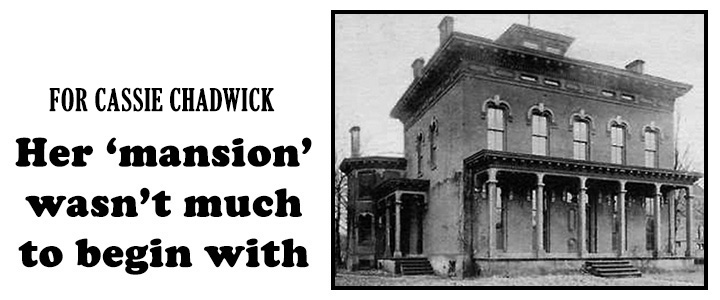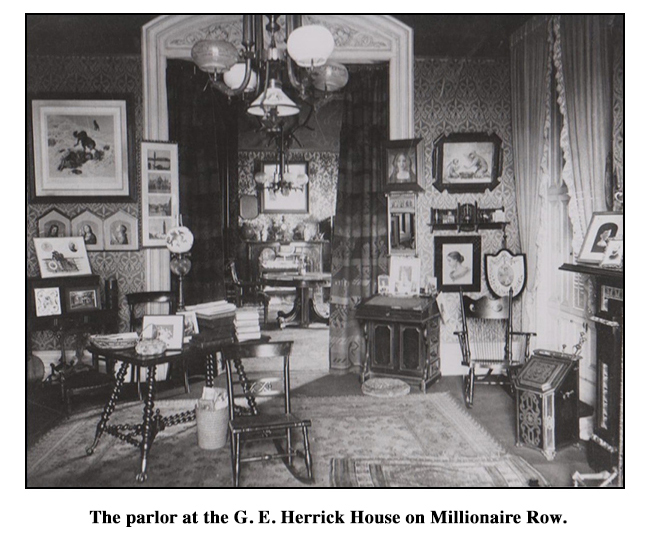| HOME | FAMILY | YESTERDAY | SOLVAY | STARSTRUCK | MIXED BAG |
 |

Part eight: About the house. Despite what many have written, it was not part of Cleveland's Millionaire Row. The street numbering system, changed in 1923, gives a clearer picture of the location of the Chadwick house, which was demolished in 1910 and replaced by the Euclid Avenue Temple. The temple relocated in 1956, and the building was sold to Liberty Hill Baptist Church, which remains at that location today in the building that was the Euclid Avenue Temple. When the Chadwicks lived in their house, its street number was 1824, and the nearest intersection was Genesee Avenue. Today its number is 8206, and Libert Hill Baptist Church sits at the intersection of Euclid Avenue and East 82nd Street. Millionaire Row went out of existence in the 1920s; when it did exist, the rich folks' mansions ran along Euclid from East 9th Street to East 55th, though some sources draw the easternmost line at East 41st Street. So the Chadwick house was about a mile away. Granted, the Chadwick house was bigger than the average American house, but it was plain-looking on the outside, and, until Cassie came along, drab on the inside. That would soon change, thanks to a surprise Christmas present Mrs. Chadwick arranged for her husband. |
|
|
|
| No specific Christmas is mentioned in the stories I've read about this gift, but I'm guessing it was their second Christmas together, in 1898, because that year Dr. Chadwick's life became less complicated, his house less crowded, with the death of his mother, Isabel Jolly Chadwick, on March 25, and the passing of his sister, Clara Catherine Chadwick, on October 13. His mother was 84, his sister 53. However, I suppose it's possible she began her renovation of the interior of the Chadwick house a year earlier. | |
| * * * | |
Money can't buy taste That was just the beginning of a spending spree that had many Clevelanders talking, but much of what they said was not complimentary. |
|
|
|
Enough already! Seems people who were around at the time enjoyed making fun of someone who didn't belong anywhere near the high class residents of Millionaire Row. While society matrons were unaware of Mrs. Chadwick's criminal past, they knew she was an outsider, and made no effort to accept her. Unfortunately, I found no photo of the interior of the Chadwick house during the Cassie years, but I did find one interior photo of a Millionaire Row home that belonged to G. E. Herrick, who made his millions in railways — more along the lines of streetcars than long-haul railroads, I think. Anyway, I can't imagine Cassie Chadwick's interior decorating was any worse than whoever put this room together: |
|
 |
|
But it is interesting that today those with a vested interest in the history of Cleveland's Millionaire Row make a point of mentioning Cassie Chadwick as one of its more famous residents when she actually wasn't — a resident of Millionaire Row, that is. As for her appeal, she began her biggest con when she was 44 years old, and by then couldn't do it with her looks, except for a facial expression that convinced several people she could be trusted. Then she set out to exploit two other male weaknesses — greed and their low opinion of a woman's intelligence. She spent her last three years engaged in crook on crook crime. Technically, she was the guilty party, but what the bankers charged her for her loans was little short of highway robbery. Not that she cared. |
|
| * * * |
A legend is born |
|
|
|
It was said she bought several diamond rings at a time, and once purchased eight grand pianos from a piano store, making them gifts to her friends, or, more likely, people she wanted to impress. Included in the many 1904 articles that flooded newspaper at the time of her arrest was an item that said, on one day, Mrs. Chadwick purchased 56 diamond rings as gifts. Another story is she once took twelve young girls to Europe for the summer, and showered them with luxury. Or was it twenty young girls? Or merely four? It depends on who is doing the telling. "Mrs. Chadwick was equally lavish in the matter of dress, and equally eccentric," the Sunday Tribune article went on. "A sealskin coat, reaching below the knees, would be a pretty present to give a dear friend. Mrs. Chadwick gave one to her cook." The New York Sun (December 14, 1904) carried this item from Owatonna, Minnesota. |
|
|
|
There were four Chadwick brothers at the time. In addition to Dr. Leroy Chadwick and Judge Miles B. Chadwick, there were James. D. Chadwick, the Franklin, Pennsylvania, lawyer, and Bingham H. Chadwick, who lived in Jacksonville, Florida. It's possible, I suppose, that Dr. Chadwick married Cassie Hoover in the belief she was wealthy, and felt her lavish spending made him seem all the more successful. But while the Owatonna Chadwicks might not have been suspicious about their new sister-in-law, the Pennsylvania Chadwicks had reason to be concerned and wonder if they had footed at least part of the bill for the European trip: |
|
|
|
Mrs. Chadwick was slow to repay the loans, and the matter fell into the hands of F. W. Echols, vice-president of the Franklin Savings Bank. A story in he New York Sun (December 12, 1904) used a wonderful phrase to describe what Echols did. He "used methods that brought Mrs. Chadwick to terms." Those methods were legal, and involved taking steps to have Cassie Chadwick declared bankrupt. "Mrs. Chadwick learned of this and in the first mail sent a check for $2,000," said the newspaper. "This was followed by further broken promises which compelled Mr. Echols once more to threaten proceedings. The result was the same: another check for $2,000. The second and last payment was made in September." Echols said he would have exposed Mrs. Chadwick had she not made the payments. Late in 1904, a less patient Brookline, Massachusetts man named Herbert D. Newton became very nervous about the money he had loaned Cassie Chadwick, and filed suit, claiming she owed him $190,800. Other creditors followed, and it soon became clear none of them had a chance of being repaid. Because of Cassie Chadwick, it would be a blue, blue Christmas for many people in 1904. |
| HOME | CONTACT |
